Posted: September 22nd, 2015 | No Comments »
As Xi visits DC – perhaps a good time to recall previous US engagements with China….Gregory Moore’s Defining and Defending the Open Door Policy….
 There has been little examination of the China policy of the Theodore Roosevelt administration. Works dealing with the topic fall either into brief discussions in biographies of Roosevelt, general surveys of Sino-American relations, or studies of special topics, such as the Chinese exclusion issue, which encompass a portion of the Roosevelt years. Moreover, the subject has been overshadowed somewhat by studies of problems between Japan and the United States in this era. The goal of this study is to offer a more complete examination of the American relationship with China during Roosevelt’s presidency. The focus will be on the discussion of major issues and concerns in the relationship of the two nations from the time Roosevelt took office until he left, something that this book does for the first time. Greater emphasis needs to be placed on creating a more complete picture of Teddy Roosevelt and China relations, especially in regard to his and his advisers’ perceptual framework of that region and its impact upon the making of China policy. The goal of this study is to begin that process. Special attention is paid to the question of how Roosevelt and the members of his administration viewed China, as it is believed that their viewpoints, which were prejudicial, were very instrumental in how they chose to deal with China and the question of the Open Door. The emphasis on the role of stereotyping gives the book a particularly unique point of view. Readers will be made aware of the difficulties of making foreign policy under challenging conditions, but also of how the attitudes and perceptions of policymakers can shape the direction that those policies can take. A critical argument of the book is that a stereotyped perception of China and its people inhibited American policy responses toward the Chinese state in Roosevelt’s Administration. While Roosevelt’s attitudes regarding white supremacy have been discussed elsewhere, a fuller consideration of how his views affected the making of foreign policy, particularly China policy, is needed, especially now that Sino-American relations today are of great concern.
There has been little examination of the China policy of the Theodore Roosevelt administration. Works dealing with the topic fall either into brief discussions in biographies of Roosevelt, general surveys of Sino-American relations, or studies of special topics, such as the Chinese exclusion issue, which encompass a portion of the Roosevelt years. Moreover, the subject has been overshadowed somewhat by studies of problems between Japan and the United States in this era. The goal of this study is to offer a more complete examination of the American relationship with China during Roosevelt’s presidency. The focus will be on the discussion of major issues and concerns in the relationship of the two nations from the time Roosevelt took office until he left, something that this book does for the first time. Greater emphasis needs to be placed on creating a more complete picture of Teddy Roosevelt and China relations, especially in regard to his and his advisers’ perceptual framework of that region and its impact upon the making of China policy. The goal of this study is to begin that process. Special attention is paid to the question of how Roosevelt and the members of his administration viewed China, as it is believed that their viewpoints, which were prejudicial, were very instrumental in how they chose to deal with China and the question of the Open Door. The emphasis on the role of stereotyping gives the book a particularly unique point of view. Readers will be made aware of the difficulties of making foreign policy under challenging conditions, but also of how the attitudes and perceptions of policymakers can shape the direction that those policies can take. A critical argument of the book is that a stereotyped perception of China and its people inhibited American policy responses toward the Chinese state in Roosevelt’s Administration. While Roosevelt’s attitudes regarding white supremacy have been discussed elsewhere, a fuller consideration of how his views affected the making of foreign policy, particularly China policy, is needed, especially now that Sino-American relations today are of great concern.
Posted: September 22nd, 2015 | No Comments »
If you’re in Hong Kong then this is probably worth a look, and maybe a chance to get rid of some annoying cash hanging about….
The Mapping of Asia
A collection of fine antique maps from 16th to 20th century
including a group of city plans
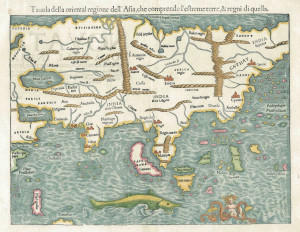
Sebastian Munster – Asia c.1540
The exhibition continues until 17th October 2015
Wattis Fine Art Gallery
20 Hollywood Road, 2/F, Central, Hong Kong
www.wattis.com.hk
Gallery open: Monday – Saturday 11am – 6pm
Posted: September 21st, 2015 | 1 Comment »
A lot has been written about Charlie Chan and the movies spawned from the books by Earl Derr Biggers. The movies played in the cinemas of the International Settlement of Shanghai and did not recieve any protests or censorship problems from the Nationalist government, as a number of movies deemed anti-Chinese did. In general in Shanghai Chan was seen as a positive character. When Warner Oland, the Swedish actor who played Chan in the majority of the Hollywood adaptations, visited China there was great interest in his visit, despite the issue of Yellowface.
America it seems was also interested in the fact that there were a series of Charlie Chan movies made in Shanghai starring Chinese actors (see advert below) – in these films (made initially in Shanghai and then, during the 1940s, Hong Kong) the detective has a daughter assisting him rather than a son. the actor Xu Xinyuan played Chan.
Anyway, here, from the American papers in 1937, is a cartoon of Xin noting the oddity of a Chinese imitating a Swede imitating a Chinese!!
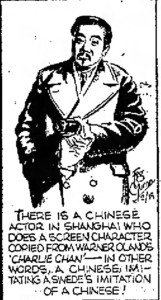
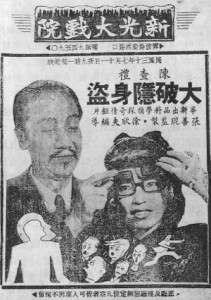
Posted: September 20th, 2015 | No Comments »
RASÂ LECTUREÂ Â
Tuesday 22 September 2015
7:00 PM for 7:15 PM start
Radisson Blu Plaza Xingguo Hotel, Tavern Bar
78 XingGuo Road, Shanghai
Doug Clark on
GUNBOAT JUSTICE
How British and American judges and lawyers changed the history of China and JapanÂ
Foreign gunboats forced China, Japan and Korea to open to the outside world in the mid-19th century under treaties which required all three countries to exempt foreign nationals from local laws. This led to the establishment of British and American court systems which operated in China for over 100 years and in Japan for almost half a century. This system of Extraterritoriality has had a huge impact on how China and Japan view the world and impacts to this day on their mutual relationship, argues Douglas Clark in his new book, Gunboat Justice.
Gunboat Justice, published in three volumes by Earnshaw Books, is a full history of the era of extraterritoriality and the British and American courts that administered Western justice over their nationals in the Far East. Gunboats were often called in to quell local opposition to the courts’ authority. This book presents a fascinating cast of characters both on and before the bench and the many challenging issues the courts faced including war, riots, rebellion, corruption, murder, infidelity, and even a failed hanging in a British jail in Shanghai.
The book contains with over 300 contemporaneous cartoons, illustrations and photos of the judges, lawyers, court cases and historical events that affected the courts.
Praise for Gunboat Justice
“A riveting work. The original research has obviously been extensive and the style is easy, disguising the erudition behind it.”
-Rt. Hon. Sir Robin Jacob, Former Lord Justice of Appeal, Professor, University College of London
“A vital read. Here we find a century of foreign judges, lawyers and consuls attempting to control a city that attracted a legion of adventurers, criminals and sharks like no other in history. Gunboat Justice reveals the intersection of Shanghai’s formal administration and its dark underbelly. The most important book on Shanghai’s history for several decades.”
-Paul French, author of Midnight in Peking, winner of the Edgar Allan Poe award for best Fact Crime writing
“For the first time, we now have a comprehensive, well-informed and humane account of the people and procedures in the British and American courts of East Asia. Doug Clark’s book brings that world to life, and restores it to its place in our histories of the era of the ‘unequal treaties’.”Â
-Robert Bickers, author of Empire Made Me, and The Scramble for China 1832-1914
“A fascinating account of an extraordinary historical period with a wealth of intriguing characters – and a serious matter at its core.”Â
-Jonathan Fenby, Author of the Penguin History of Modern China
A pathbreaking study of an important but long neglected topic, this book is a fascinating read and invaluable resource for anyone with an interest in law, empire and history in modern East Asia.
 -Dani Botsman, Professor of History, Yale University, author of Punishment and Power in the Making of Modern Japan
Talk Cost: RMB 70.00 (RAS members) and RMB 100.00 (non-members). Includes glass of wine or soft drink. Those unable to make the donation but wishing to attend may contact us for exemption.
Membership applications and membership renewals will be available at this event. Those unable to make the donation but wishing to attend may contact us for exemption.
RAS Monographs: Series 1 & 2 will be available for sale at this event. RMB 100 each (cash sale only).
To RSVP:Â Please “Reply” to this email or write to
RAS Bookings at: bookings@royalasiaticsociety.org.cn
Posted: September 19th, 2015 | No Comments »
Plenty has been written on the popularity of Jazz in interwar Shanghai and the large number (comparatively) of African-American jazz musicians, singers and bands that passed through the city. I won’t rehash everything here – black musicians had been appearing in Shanghai since the early part of the twentieth century (as chronicled in a number of books including Andrew Field Shanghai’s Dancing World) and this process accelerated as Shanghai, both Chinese and Shanghailander, came to appreciate and want more jazz. The factors attracting African-American musicians and entertainers were multiple of course:
- Social – Shanghai was generally perceived as being somewhere with distinctly less prejudice, racism and exclusionary practices than America (mostly true, though racism both formal and informal did exist and was experienced – plenty of Shanghailanders were racist, some clubs and dancehalls operated informal colour bars while some places, like the American Club, operated formal bars; the 4th Marines stationed in the city were a fairly aggressive bunch too);
- Market – the growing demand for jazz in the city, the proliferation of venues and the perceived authenticity of black musicians (though obviously there was also a demand for white bands, either American, European or made up of Russians, Italians, Filipinos etc in Shanghai);
- Economic – for most of the period wages were pretty good, taxes low to non-existent and the exchange rate in America’s favour (though how you were paid, in what currency, whether you got cheated etc depended on the generosity or otherwise as well as the honesty of the employer).
Reading William A Shack”s Harlem in Montmartre, about the Paris jazz scene and specifically the crucial role of African-American musicians between the wars we can add another “push” factor that encouraged African-American entertainers to travel to Shanghai – the French 10% law…
Paris had of course been a Mecca to black American jazz musicians after World War One – black servicemen that stayed on after the Great War in the more liberal environment of Paris, more that came once word got out, others booked for European tours who found Paris congenial. However, in June 1933 France enacted the so-called 10% law. Enacted in the wake of the onset of the Great Depression in Europe the law restricted the number of foreign musicians employed by an establishment to 10%. This naturally caused a lot of unemployment and, while many stars and band leaders remained in work, many ordinary musicians found themselves unemployed.
Among those who found themselves struggling to make a living in Paris and lit out for Shanghai were:
- Bob and Teddy Drinkard – who took their floor show to the Canidrome Ballroom in Frenchtown
- Nora Holt Ray – a singer who worked in various Shanghai nightclubs
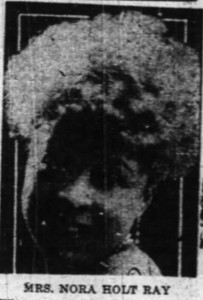
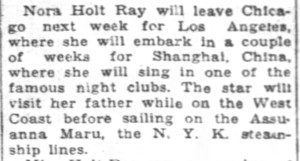
- Al Baldwin – who worked in Shanghai floor shows for six years
- Ulysses S (“Slow Kid”) Thompson – the husband of the (recently deceased) Florence Mills who got a gig at Shanghai’s Little Club
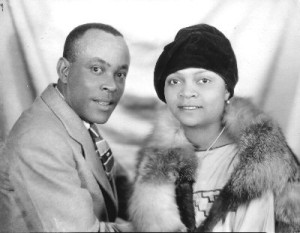 Thompson with Florence Mills
Thompson with Florence Mills
Of course after 1933, and things got tougher in Paris, American bands circumvented Europe and went straight to Shanghai with greater regularity. But it seems France’s decision to enact the 10% law saw a lot head straight to Marseilles and jump the Messagerie Maritime boat to Shanghai.
Posted: September 18th, 2015 | No Comments »
An interesting book on one of South East Asia’s most influential architects of the early twentieth century….
(and an upcoming event on Iversen at Asia House in London on November 25th)
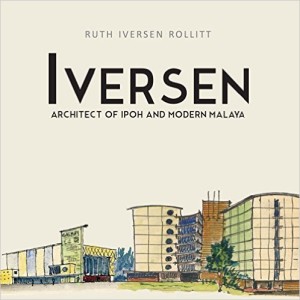
Perhaps more than any other architect of his generation, B.M. Iversen (1906 1976) introduced modern architecture to Malaya. From his award-winning Federal House and the landmark Loke Yew Building in Kuala Lumpur, to the 38 cinemas he designed for the Shaw Brothers and the Cathay Organisation, Iversen s buildings remain icons of Malaysian Art Deco and Modernist architecture. Arriving in Malaya in 1928, the young Danish architect worked for Booty & Edwards and then Keys & Dowdeswell before moving to Ipoh. There, he settled down, founded his own practice and began to experiment with variants of tropical architecture. He was joined by his Dutch friend Henk van Sitteren after the war. By the time Iversen retired in 1966, the partnership of Iversen & van Sitteren had grown into a large firm with 14 architects of Danish, Dutch, British, and Malayan nationalities. The firm was responsible for the design of thousands of buildings in Penang, Perak, Cameron Highlands, Kuala Lumpur and Singapore. Written by the architect s daughter, Ruth Iversen Rollitt, this warm, richly illustrated biography sheds new light on the life and work of Iversen, whose career spanned almost four decades in Malaya.
Posted: September 18th, 2015 | No Comments »
If tyou need a reason to visit Paris (and you shouldn’t really) here’s a couple. Not one, but two, exhibitions featuring the work of the early photographer in China and Taiwan John Thomson are taking place in Paris this autumn. One exhibit, of Thomson’s Taiwan photographs, will be held at the Maison de la China and opens in late September. The other, of Thomson’s China photographs, will be held at the Fondation Taylor beginning at the end of October. More information on both exhibitions here. For anyone interested there’s also a 15-page press kit here.

Posted: September 17th, 2015 | No Comments »
I’ve blogged before about the various tactics the Nazi authorities resident in Shanghai in the 1930s used against the Jewish population of the International Settlement (here, threatening retribution against their relatives back in Europe if they staged an anti-Nazi play in Hongkew). Here though is another tactic the Nazis used in Shanghai – dredging up the old ‘Jewish blood rituals’ nonsense.
It’s a long standing bit of rubbish used by Nazis in Europe and anti-Semites for ages….here given a Shanghai twist. The gist is that Jews had an ‘operating table’ in the Jewish cemetery in the old Eastern District (Yangpu nowadays) where they ritualistically murdered non-Jews. The Nazi slanders intimated that such ritualistic killings by Jews of non-Jews had gone on during the First World War. This was, of course, and as the Shanghai Municipal Council and the newspapers including the North-China Daily News reported, nonsense – not least because the Jewish cemetery (at 727 Baikal Road in Yangtszepoo District – now Huimi Road/Weiming Road in Yangpu) was only founded in 1917 and didn’t really come into use until 1919. However, it does show how active the Nazi propaganda machine was in spreading anti-Semitic ideas in Shanghai in the late 1930s and 1940s.
What is not totally clear is who exactly the Nazi agents were directing their propaganda at? Shanghailanders or Chinese in Shanghai.
BTW: Baikal Road was the biggest Jewish cemetery in Shanghai, consisting of 1,692 graves. The dismantling of monuments and exhumation of remains started September 1958 and was completed November 1958. Re-interment was reportedly completed on December 1958.
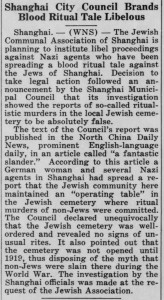
 There has been little examination of the China policy of the Theodore Roosevelt administration. Works dealing with the topic fall either into brief discussions in biographies of Roosevelt, general surveys of Sino-American relations, or studies of special topics, such as the Chinese exclusion issue, which encompass a portion of the Roosevelt years. Moreover, the subject has been overshadowed somewhat by studies of problems between Japan and the United States in this era. The goal of this study is to offer a more complete examination of the American relationship with China during Roosevelt’s presidency. The focus will be on the discussion of major issues and concerns in the relationship of the two nations from the time Roosevelt took office until he left, something that this book does for the first time. Greater emphasis needs to be placed on creating a more complete picture of Teddy Roosevelt and China relations, especially in regard to his and his advisers’ perceptual framework of that region and its impact upon the making of China policy. The goal of this study is to begin that process. Special attention is paid to the question of how Roosevelt and the members of his administration viewed China, as it is believed that their viewpoints, which were prejudicial, were very instrumental in how they chose to deal with China and the question of the Open Door. The emphasis on the role of stereotyping gives the book a particularly unique point of view. Readers will be made aware of the difficulties of making foreign policy under challenging conditions, but also of how the attitudes and perceptions of policymakers can shape the direction that those policies can take. A critical argument of the book is that a stereotyped perception of China and its people inhibited American policy responses toward the Chinese state in Roosevelt’s Administration. While Roosevelt’s attitudes regarding white supremacy have been discussed elsewhere, a fuller consideration of how his views affected the making of foreign policy, particularly China policy, is needed, especially now that Sino-American relations today are of great concern.
There has been little examination of the China policy of the Theodore Roosevelt administration. Works dealing with the topic fall either into brief discussions in biographies of Roosevelt, general surveys of Sino-American relations, or studies of special topics, such as the Chinese exclusion issue, which encompass a portion of the Roosevelt years. Moreover, the subject has been overshadowed somewhat by studies of problems between Japan and the United States in this era. The goal of this study is to offer a more complete examination of the American relationship with China during Roosevelt’s presidency. The focus will be on the discussion of major issues and concerns in the relationship of the two nations from the time Roosevelt took office until he left, something that this book does for the first time. Greater emphasis needs to be placed on creating a more complete picture of Teddy Roosevelt and China relations, especially in regard to his and his advisers’ perceptual framework of that region and its impact upon the making of China policy. The goal of this study is to begin that process. Special attention is paid to the question of how Roosevelt and the members of his administration viewed China, as it is believed that their viewpoints, which were prejudicial, were very instrumental in how they chose to deal with China and the question of the Open Door. The emphasis on the role of stereotyping gives the book a particularly unique point of view. Readers will be made aware of the difficulties of making foreign policy under challenging conditions, but also of how the attitudes and perceptions of policymakers can shape the direction that those policies can take. A critical argument of the book is that a stereotyped perception of China and its people inhibited American policy responses toward the Chinese state in Roosevelt’s Administration. While Roosevelt’s attitudes regarding white supremacy have been discussed elsewhere, a fuller consideration of how his views affected the making of foreign policy, particularly China policy, is needed, especially now that Sino-American relations today are of great concern.








